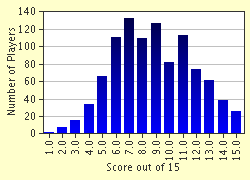Quiz Answer Key and Fun Facts
1. Who proposed the double-helical model of the DNA?
2. Nucleotides are monomers of DNA. What does each nucleotide consist of?
3. Chargaff's rules states that the ratio of the purines to pyrimidines in the double-stranded DNA is always constant at 1.
4. Is RNA polymerase required for in vivo DNA replication?
5. What are Okazaki fragments?
6. In eukaryotes, transcription of mRNA is 1)catalyzed by what type of enzyme 2)initiated by binding of transcription factors to which important promoter sequence?
7. There are 20 essential amino acids in the human body. Using the triplet codon, theoretically, how many amino acids can be coded for?
8. Why does a single base substitution in DNA base sequence not necessary result in a malfunctional polypeptide?
9. Translation requires the activation of amino acid into which of these?
10. Which molecule is not required during translation?
11. Bam HI restriction site is within tetracycline resistant gene. A foreign gene is inserted into a plasmid using Bam HI. When bacteria with the recombinant plasmid is grown in tetracylcine, will it die?
12. What is the name of the enzyme that catalyzes formation of DNA from mRNA?
13. Sickle cell anaemia is a disease resultant of missense mutation. What codon number in the DNA sequence does the mutation take place? What amino acid substituted the original glutamic acid? This mutation affects which protein chain in the hemoglobin?
14. What are involved in removal of introns from the pre-mRNA?
15. What is the start codon in mRNA for protein synthesis?
Source: Author
Garhobbs
This quiz was reviewed by FunTrivia editor
crisw before going online.
Any errors found in FunTrivia content are routinely corrected through our feedback system.


